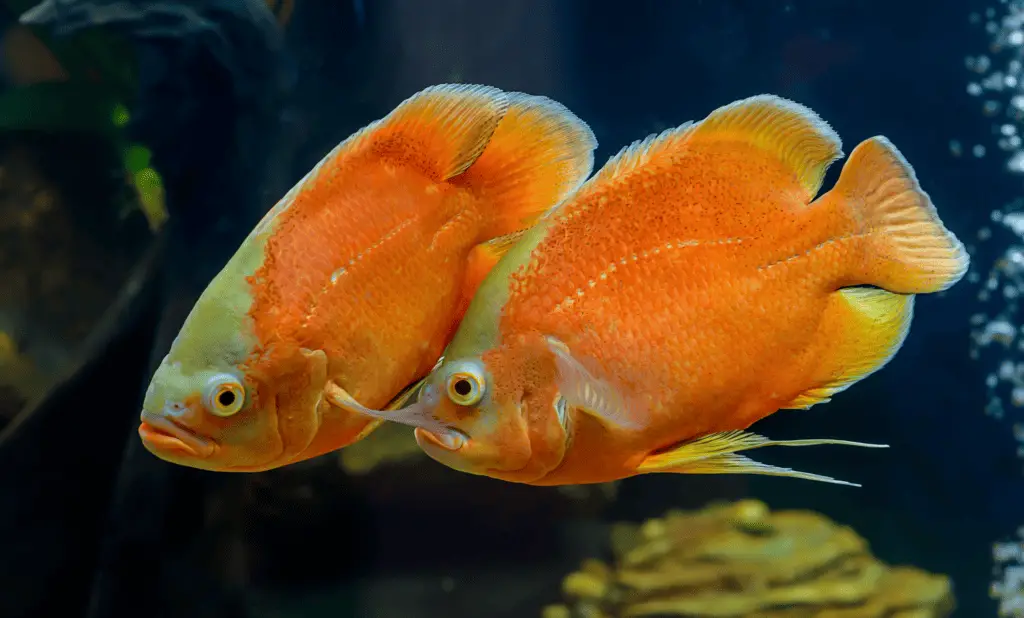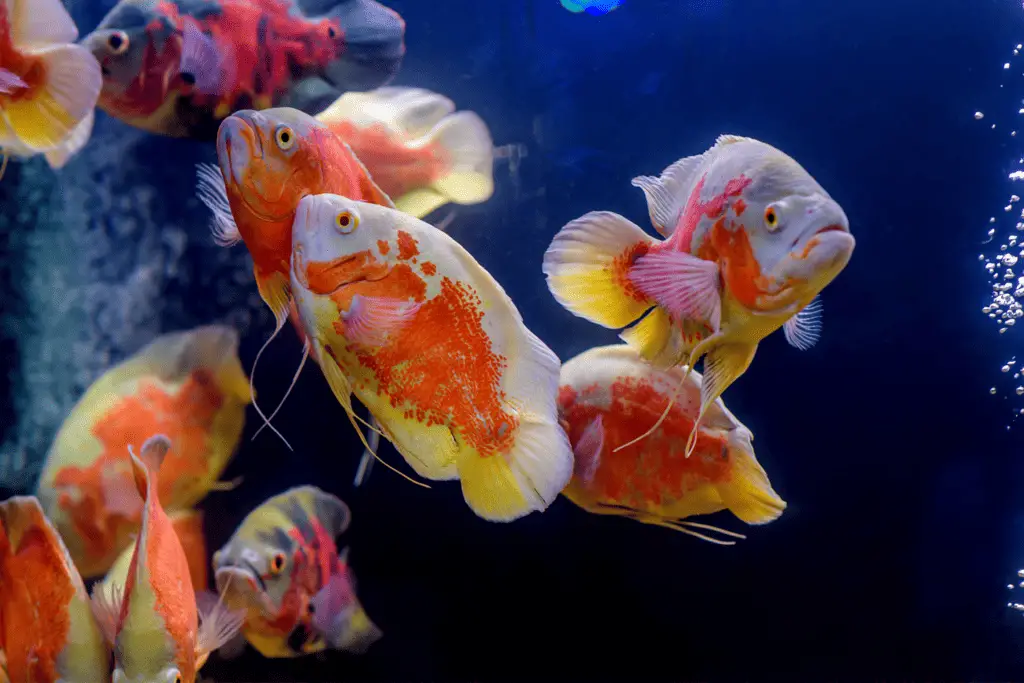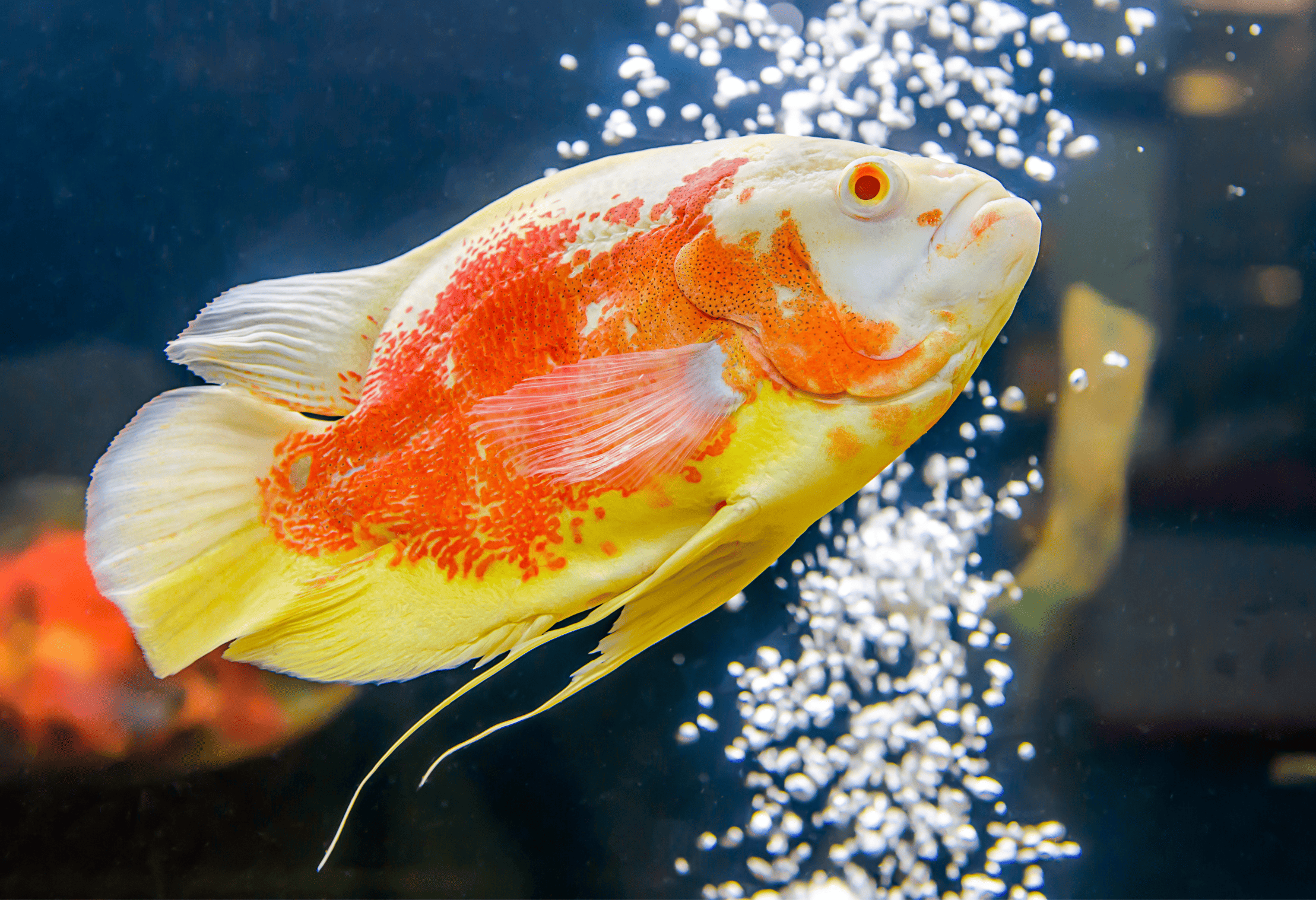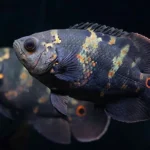Oscar fish, scientifically known as Astronotus ocellatus, are a popular and fascinating species of freshwater fish native to the tropical regions of South America. They are predominantly found in countries along the Amazon basin, including Peru, Brazil, French Guiana, Colombia, and Ecuador. Their natural habitat consists of slow-moving water bodies, abundant in rocks and debris that provide an ideal space for them to thrive.
As members of the cichlid family, Oscar fish are known to be large, personable, and somewhat aggressive in nature. Reaching up to 14 inches in length in the wild and up to 12 inches in captivity, these fish require a decent amount of space and proper care. They are monomorphic, making it relatively difficult to differentiate between males and females based on physical appearance alone.
In aquariums, Oscar fish usually have a lifespan between eight and 15 years. Providing a well-rounded diet, comprising of pelleted cichlid food and protein-rich supplements like bloodworms, tubifex worms, and frozen krill, is essential for their health and well-being. Known for their distinct appearance, Oscars have become a favorite among fish enthusiasts who appreciate their unique character and striking looks.
Overview of Oscar Fish
Astronotus Ocellatus
Oscar fish, scientifically known as Astronotus ocellatus, are a popular freshwater aquarium species native to South America. They are known for their striking appearance, with a mix of colors and interesting patterns. Oscar fish are generally robust and hardy, making them suitable for both beginners and experienced aquarists.
- Size: Oscars can grow between 12 and 18 inches long, with larger sizes being relatively rare in captivity.
- Weight: When fully mature, these fish can weigh up to 3 pounds.
- Lifespan: In the wild, Oscar fish can live for about 20 years. In captivity, they generally live between 8 and 15 years.
Amazon River Basin
Oscar fish originate from the tropical regions of South America, specifically the Amazon River basin. They are often found in shallow, slow-moving, and slightly cloudy waters throughout the basin. Due to their popularity as aquarium fish, they have also been introduced to many areas worldwide, where they are commercially produced.
Family Cichlidae
Being members of the Cichlidae family, Oscar fish exhibit certain behaviors and characteristics typical of cichlids:
- Monomorphic: Males and females are difficult to distinguish based on physical appearance, as there are no obvious differences in size or coloration.
- Diet: Oscars are carnivorous and require a protein-rich diet. In addition to a high-quality pelleted cichlid diet, they benefit from meaty supplements such as bloodworms, tubifex worms, and frozen krill.
Adaptable and fascinating, the Oscar fish offers an excellent choice for aquarium enthusiasts looking to add a bit of South American flair to their collection. Its place in the Cichlidae family and origin in the Amazon River basin makes it an interesting species to study and care for.

Appearance
Color Variations
Oscar Fish (Astronotus ocellatus) are known for their beautiful and varied coloration. They originated from the tropical regions of South America and are found in countries along the Amazon basin. Here, we will discuss a few common types of Oscars and their distinctive color patterns.
-
Tiger Oscar: These Oscars have dark bodies with vibrant orange or red stripes, similar to a tiger’s pattern. The orange and black contrast gives the fish an attractive appearance.
-
Velvet Cichlid: Sometimes referred to as the Black Oscar, this variant displays a deep black color with silver speckles. These Oscars have an almost velvet-like appearance, hence its name.
-
Marble Cichlid: The Marble Oscar has a mix of dark and light patterns, usually appearing like a combination of black, grey, and white colors, which resembles the appearance of marble.
-
Albino Oscar Fish: These Oscars lack pigmentation, causing their appearance to be a pale or whitish color. Occasionally, they may have faint hints of yellow or pink.
-
Red Oscar Fish: As the name suggests, Red Oscars exhibit a bright red coloration, often mixed with black patterns, which makes them highly sought-after by enthusiasts.
-
Longfin (Veilfin) Oscar: Longfin Oscars are characterized by their flowing, gown-like fins, which have been bred to be longer and more eye-catching. These Oscars can exhibit coloration similar to other variants mentioned.
While these are some popular examples of Oscar Fish color variations, it’s important to note that individual fish may vary in appearance. Their vibrant colors, interesting patterns, and elegant appearances make Oscars a popular choice among fish enthusiasts. However, they can grow quite large, reaching up to 12 inches in captivity, and require adequate tank size and care to thrive.
Behavior and Temperament
Oscar fish are known for their unique personality traits and behavior. They are intelligent freshwater fish with a territorial and aggressive nature. This cichlid fish originates from South America and displays beautiful coloration and patterns, making them a popular choice for aquarium hobbyists.
Oscars are generally territorial, which means they prefer to establish and protect a certain area in the tank as their own. This territorial behavior can lead to aggression towards other fish. Thus, it’s important to provide enough space in the tank and add hiding spots, such as rocks and caves, to minimize conflicts.
Regarding aggression, Oscar fish are known to be quite assertive, especially when they feel threatened or are defending their territory. Their aggression is not restricted to fish of the same species, but could also be directed towards other tank mates. This makes it vital to choose compatible tank mates and monitor their behavior closely to avoid stress and harm to the fish.
In terms of intelligence, Oscar fish are considered to be one of the smarter cichlid species. They are capable of recognizing their owner and can even perform tricks if trained. This high intelligence level makes them more interactive than some other aquarium fish, and they have been known to form bonds with their keepers.
When it comes to social behavior, Oscar fish can be quite intriguing. Despite their aggression, they may form social hierarchies in the tank and can exhibit different behaviors depending on their mood or surroundings. If well cared for, Oscars can become more docile and used to human interaction.
To sum up, Oscar fish display a range of behaviors, from territorial and aggressive to intelligent and social. It’s essential to provide adequate tank space and ensure compatibility with tank mates to maintain a healthy environment for these fascinating creatures.
Tank Setup
Tank Size
Oscar fish can grow up to 12 inches (30 cm) in length and weigh around 3 pounds when fully mature. To accommodate their size, the ideal tank size for a single Oscar is at least 55 gallons. If you plan to own multiple Oscar fish, you should add at least 25 additional gallons of water for each new Oscar:
- 1 Oscar: 55 gallons
- 2 Oscars: 80 gallons
- 3 Oscars: 105 gallons
- 4 Oscars: 130 gallons
Water Parameters
Oscars thrive in specific water conditions, and maintaining these parameters is essential for their health. Here are the recommended water parameters for Oscars:
- Temperature: 77 – 80°F (25 – 27°C)
- pH: 6.0 – 8.0
- Ammonia, Nitrite, Nitrate: close to 0 ppm (parts per million)
Filtration
Oscar fish produce a lot of waste, so an efficient filtration system is necessary to maintain a clean and healthy tank. Hang-on-back filters or canister filters are suitable options for Oscar fish tanks. Regularly check the filter and clean it if needed to ensure proper function.
Heaters
Since Oscar fish prefer warmer water, you’ll need an aquarium heater to maintain the desired temperature. Choose a heater rated for the size of your tank, and consider adding a thermometer for easy monitoring.
Plants and Decorations
Live plants are not necessary for Oscar fish tanks, but they can provide a more natural habitat. Hornwort is an option to consider as it is hardy and can survive in a variety of conditions. However, keep in mind that Oscars can be destructive with plants and decorations, so choose sturdy plants and secure any decorations in the tank.

Diet
Oscar fish have an omnivorous diet, which means they eat a combination of plant matter and animal-based food sources. Their preferred meals in the wild mostly consist of insects, crustaceans, and small fish, such as catfish. To mimic this diverse diet in captivity, it’s essential to provide a variety of food options for your Oscar fish.
Live foods can be an excellent addition to their diet as they closely resemble what Oscars would eat in their natural habitat. Some suitable live food options include:
- Small feeder fish
- Insect larvae
- Crayfish or shrimp
However, it’s crucial to sourcing live foods from reputable suppliers to avoid introducing parasites or disease to the aquarium.
Pellet foods, specifically formulated for cichlids, can serve as a staple in their diet, providing balanced nutrition that helps promote growth. Feeding Oscars with high-quality pellets ensures they get the necessary nutrients required for maintaining good health. Pellets come in various sizes, so make sure to choose the appropriate size for your fish.
In addition to live and pellet foods, you can also offer your Oscar fish a mix of frozen options, such as:
- Bloodworms
- Brine shrimp
- Daphnia
These frozen foods provide essential nutrients and variety to their diet. Make sure to thaw them properly before feeding.
Even though Oscars are primarily meat-eaters, providing small amounts of plant matter can benefit their overall health. Offer blanched vegetables, like spinach, zucchini, or peas, as occasional treats to supplement their primary diet.
Feeding your Oscar fish a well-rounded, nutritious diet is crucial for their long-term health and well-being. Remember to provide variety to their meals, using both high-quality pellet foods and a mix of live or frozen options. Supplementing with plant matter also helps ensure they receive a broad spectrum of nutrients.
Tank Mates
When considering tank mates for your Oscar fish, it is essential to keep in mind that they can be quite aggressive and territorial. However, with careful planning and compatible species, it is possible to create a more harmonious community tank environment for them.
Some suitable tank mates for Oscar fish include:
-
Silver Dollars (Metynnis spp.): These peaceful fish are known for their flat, disc-shaped bodies and silver coloration. They can grow up to six inches, making them a good match for the size of Oscar fish. Silver dollars prefer living in groups, so it is advisable to keep at least five together to reduce stress and maintain a healthy social structure.
-
Jack Dempseys (Rocio octofasciata): Named after the famous American boxer, Jack Dempseys are known for their aggression and territoriality. By having similar temperaments, they can coexist with Oscar fish, but it is crucial to provide ample hiding spaces and territory. Monitor their interactions, as individual personalities can vary, and adjustments may be necessary.
-
Convict Cichlids (Amatitlania nigrofasciata): These small, aggressive fish can be suitable tank mates for Oscar fish when kept in a large, well-decorated tank. With distinct black stripes and a feisty personality, Convict Cichlids can hold their ground against an Oscar. Make sure to keep a close eye on them, as they are known to breed prolifically and may become more aggressive while defending their offspring.
It is crucial to provide a spacious tank and create a suitable habitat for all inhabitants to reduce the chances of aggression and territorial disputes. A proper setup should include hiding spots, such as rocks and logs, to ensure each fish can retreat to its own space. Always observe the tank dynamics closely, as compatibility depends on the individual personalities and environmental conditions in the aquarium.
Breeding
Spawning
Oscar Fish (Astronotus ocellatus) are native to tropical regions of South America and prefer slow-moving waters with sunken branches and logs. To encourage spawning in captivity, provide a soft substrate and hiding spots such as rocks or PVC pipes. Oscars typically form breeding pairs and will engage in courtship behaviors like lip locking and body rubbing. The female will lay between 300 to 3,000 eggs, depending on her size, on a flat surface chosen by the pair.
Egg Care
During the incubation period, the Oscar breeding pair will diligently care for their eggs. They will:
- Fan the eggs with their fins to provide oxygen
- Remove any fungus-affected eggs
- Guard against potential predators
To ensure optimal egg health, maintain a neutral water pH level between 6 and 8 and test the water regularly. Keep the aquarium clean and free of ammonia by conducting weekly partial water changes (15-25%) during this time.
Fry Development
After approximately 2-5 days, the eggs will hatch and release the tiny, underdeveloped Oscar fry. The pair of Oscar parents will move the fry to a new location, such as a shallow pit they create in the substrate. Fry will hold onto surfaces with their mouths as they continue to develop. During this period, it is essential to:
- Ensure steady water temperature between 77-82°F (25-28°C)
- Maintain good water quality
- Provide proper nutrition, such as newly hatched brine shrimp and crushed flake food
Brood Care
Oscar parents are protective and attentive towards their brood, constantly watching over the fry and ensuring their wellness. In about 10-12 days, the Oscar fry will begin swimming freely but will still be under the care and protection of their parents. Be cautious during this stage, as the brood may be at risk from tankmates or overly aggressive parents. If necessary, separate the fry into a separate grow-out tank to allow them to develop independently.
Oscar Fish Care
Oscar fish are a popular choice among aquarists for their unique personality and beautiful colors. They belong to the family Cichlidae and require specific care as these large, monomorphic fish can grow up to 12 inches in length. In this section, we will discuss some key aspects of Oscar fish care to help both beginners and experienced fishkeepers maintain a healthy environment for their pets.
Tank Size
Tank size is an important factor for Oscar fish, as smaller tanks can lead to poor water quality and stress, which can impact the fish’s health. For a single Oscar, the recommended tank size is at least 55 gallons, with an additional 25 gallons of water per new Oscar.
Recommended tank sizes for multiple Oscars:
- 1 Oscar: 75 gallons
- 2 Oscars: 125 gallons
- 3 Oscars: 150-200 gallons
Larger tanks are easier to maintain and offer better water quality, ultimately contributing to the longevity of your fish.
Water Parameters
Maintaining the right water parameters is crucial for the overall health of your Oscar fish. They prefer a temperature between 75 and 80 degrees Fahrenheit (23 – 27°C) and a pH balance of 6 to 8. Oscars can tolerate a wide range of water hardness, but it is recommended to keep the water between 12dH and 15dH. Regular monitoring and adjustments of the water parameters are essential to ensure the stability of their environment.
Diet and Feeding
Oscar fish have a varied diet, which should include high-quality pellets or flakes as a staple, along with occasional frozen or live foods as treats. Feeding them a balanced diet improves their immune system and promotes healthy growth. It is usually sufficient to feed them once or twice a day, but be careful not to overfeed them to maintain stable water quality.
Tank Mates
Oscar fish can be fairly aggressive, so choosing the right tank mates is critical for a harmonious living environment. It is best to avoid placing them with smaller or slow-moving fish. Instead, consider other large or semi-aggressive fish from the cichlid family or similar species that can coexist peacefully with Oscars.
By understanding the specific care requirements of Oscar fish, aquarists can create a healthy and enjoyable environment for these fascinating pets.
Recognizing Potential Issues
Oscar fish are known for their vibrant colors and interesting personalities, but just like any other pets, they can also suffer from various health issues. As an Oscar fish owner or enthusiast, it’s essential to recognize some common diseases and their symptoms to ensure the health and well-being of your treasured aquatic friend.
One common issue is Hole in the Head (HITH) disease. This condition manifests as small, eroded pits on the fish’s head, often concentrated around the eyes and forehead. HITH is usually caused by a lack of essential nutrients or poor water quality, so be sure to maintain a healthy diet and clean environment for your oscars.
Oscar fish also frequently experience fin rot and tail rot, which are bacterial infections affecting the edges of their fins and tails. Symptoms include ragged, torn fins and a gradual disintegration of the tail tissue. To prevent these conditions, maintain clean water, monitor water chemistry, and handle your fish with care to minimize stress.
Another common ailment is popeye disease, which causes a swelling of the eyes. This swelling can be an infection or caused by other factors such as injury or poor water quality. Keep a close eye on your Oscar fish’s eyes and take action if you notice them becoming swollen or cloudy.
Lastly, Costia infestation is another issue you may encounter. This parasite damages the fish’s skin and gills, leading to cloudy eyes, red or white spots on the body, dull or ragged fins, and increased mucus production. To avoid this, ensure proper filtration in the aquarium and avoid overcrowding.
In summary, here are some key points to remember when recognizing potential issues with Oscar fish:
- Keep an eye for symptoms such as pits on the head, eroded fins or tail, swollen eyes, and spots on the body
- Always maintain clean water, proper water chemistry, and a stress-free environment for your fish
- Consult a professional or aquatic veterinarian if you notice any of the symptoms mentioned above
By staying vigilant and proactive in addressing potential health concerns, you can ensure your Oscar fish remains happy and healthy.
Species Overview
The Oscar fish (Astronotus ocellatus) is a popular freshwater fish from the cichlid family. Found mainly in the Amazon and Orinoco River basins in South America, these colorful and intelligent fish have been grown to popularity in the aquarium hobby due to their personality and striking appearance.
There are several types of Oscar fish, each with unique colorations and patterns. Some common varieties include:
- Tiger Oscar: characterized by its orange and black striped pattern
- Red Oscar: mostly red with some black markings
- Albino Oscar: lacking pigmentation, appearing white or cream
- Marble Cichlid: a mix of colors, typically black, red, and white
The highly adaptable nature of Oscars, along with their opportunistic feeding habits, have allowed them to thrive in their native habitats. These environments consist of slow-moving, warm, and murky waters, which provide ample opportunities for them to catch their prey.
In the wild, the diet of an Oscar fish comprises of various small fish, crustaceans, and insects. As a result, they are classified as carnivorous fish. In captivity, they can be fed a well-rounded diet, including high-quality cichlid pellets, bloodworms, tubifex worms, and frozen krill.
An adult Oscar fish can range in size from 10 to 15 inches and weigh up to 3.5 pounds, depending on their environment and care. The females tend to be slightly smaller, with an average size of 10 to 12 inches.
Oscar fish are not considered endangered, and while they are mainly kept as aquarium pets, they are also valued as a food fish by artisanal fishers in some parts of South America. Due to their adaptability, they have been introduced to areas outside their native habitat, such as India and China, where they have established populations.
In summary, the Oscar fish is a fascinating and colorful species that has been a favorite among aquarium enthusiasts. Originating from the warm, murky waters of South America, they are a vibrant addition to the freshwater cichlid family. With numerous types and distinct appearances, they offer a unique experience for both new and seasoned fish keepers.
Conclusion
Oscar fish, native to the tropical regions of South America, are eye-catching and popular among aquarium enthusiasts. These fish are known for their unique appearance, with albino Oscars having a predominantly white color while red Oscars display a vivid beauty with red or orange stripes.
When it comes to creating a comfortable environment, Oscar fish thrive in warm waters with a stable temperature between 74 and 81 degrees Fahrenheit (ideally 77 degrees Fahrenheit), a pH level of 6-8 (ideally 7.2), and water hardness of 5-20 KH. Tank size is essential to avoid overcrowding, for instance, one Oscar fish would require a 75-gallon tank, while two would need 125 gallons.
Breeding Oscars is achievable, albeit rare in the aquarium trade due to their aggressive nature. Providing the ideal water conditions and maintaining their specific care requirements, albino Oscar and red Oscar fish can breed in captivity. Eggs hatch within 2–3 days, and juveniles should be fed frequently to support growth.
In summary, with adequate tank size and specific water conditions, enthusiast can enjoy the captivating aesthetics of Oscar fish, while maintaining their wellbeing in captivity.






